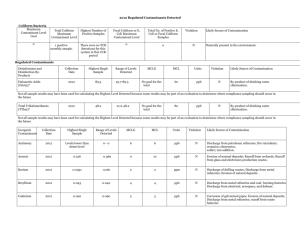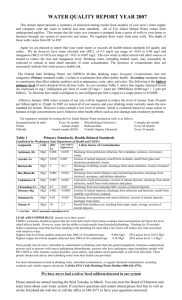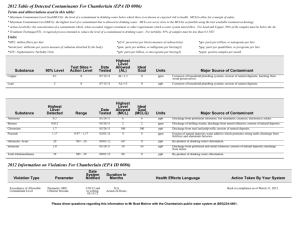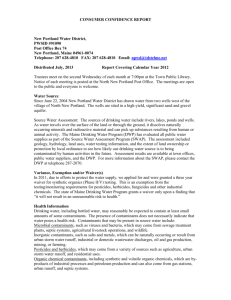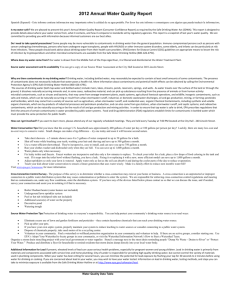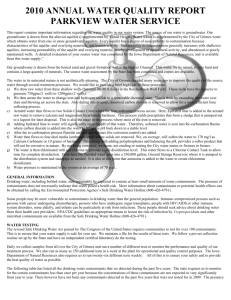2008 Drinking Water Quality Report
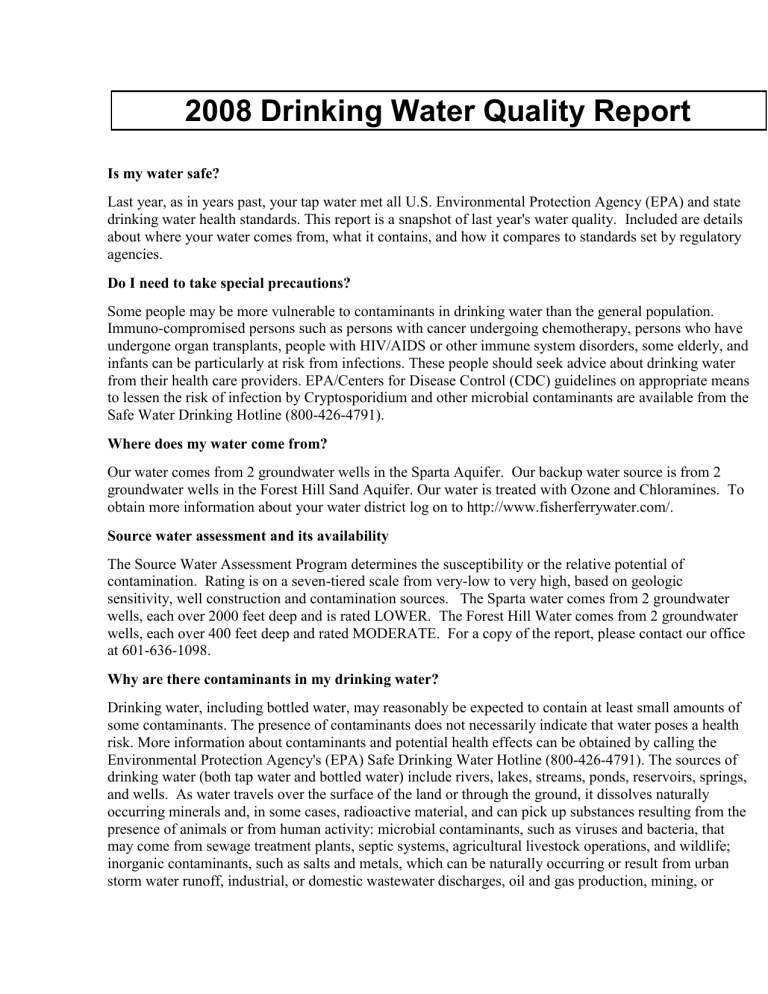
2008 Drinking Water Quality Report
Is my water safe?
Last year, as in years past, your tap water met all U.S. Environmental Protection Agency (EPA) and state drinking water health standards. This report is a snapshot of last year's water quality. Included are details about where your water comes from, what it contains, and how it compares to standards set by regulatory agencies.
Do I need to take special precautions?
Some people may be more vulnerable to contaminants in drinking water than the general population.
Immuno-compromised persons such as persons with cancer undergoing chemotherapy, persons who have undergone organ transplants, people with HIV/AIDS or other immune system disorders, some elderly, and infants can be particularly at risk from infections. These people should seek advice about drinking water from their health care providers. EPA/Centers for Disease Control (CDC) guidelines on appropriate means to lessen the risk of infection by Cryptosporidium and other microbial contaminants are available from the
Safe Water Drinking Hotline (800-426-4791).
Where does my water come from?
Our water comes from 2 groundwater wells in the Sparta Aquifer. Our backup water source is from 2 groundwater wells in the Forest Hill Sand Aquifer. Our water is treated with Ozone and Chloramines. To obtain more information about your water district log on to http://www.fisherferrywater.com/.
Source water assessment and its availability
The Source Water Assessment Program determines the susceptibility or the relative potential of contamination. Rating is on a seven-tiered scale from very-low to very high, based on geologic sensitivity, well construction and contamination sources. The Sparta water comes from 2 groundwater wells, each over 2000 feet deep and is rated LOWER. The Forest Hill Water comes from 2 groundwater wells, each over 400 feet deep and rated MODERATE. For a copy of the report, please contact our office at 601-636-1098.
Why are there contaminants in my drinking water?
Drinking water, including bottled water, may reasonably be expected to contain at least small amounts of some contaminants. The presence of contaminants does not necessarily indicate that water poses a health risk. More information about contaminants and potential health effects can be obtained by calling the
Environmental Protection Agency's (EPA) Safe Drinking Water Hotline (800-426-4791). The sources of drinking water (both tap water and bottled water) include rivers, lakes, streams, ponds, reservoirs, springs, and wells. As water travels over the surface of the land or through the ground, it dissolves naturally occurring minerals and, in some cases, radioactive material, and can pick up substances resulting from the presence of animals or from human activity: microbial contaminants, such as viruses and bacteria, that may come from sewage treatment plants, septic systems, agricultural livestock operations, and wildlife; inorganic contaminants, such as salts and metals, which can be naturally occurring or result from urban storm water runoff, industrial, or domestic wastewater discharges, oil and gas production, mining, or
farming; pesticides and herbicides, which may come from a variety of sources such as agriculture, urban storm water runoff, and residential uses; organic Chemical Contaminants, including synthetic and volatile organic chemicals, which are by-products of industrial processes and petroleum production, and can also come from gas stations, urban storm water runoff, and septic systems; and radioactive contaminants, which can be naturally occurring or be the result of oil and gas production and mining activities. In order to ensure that tap water is safe to drink, EPA prescribes regulations that limit the amount of certain contaminants in water provided by public water systems. Food and Drug Administration (FDA) regulations establish limits for contaminants in bottled water which must provide the same protection for public health.
How can I get involved?
Monthly board meetings are held on the third Tuesday at 6:30 p.m. at the water office at 5151 Nailor
Road. Our Annual Membership Meeting is held on the third Tuesday in February at 7:00 p.m. Customers are notified by postcard of the meeting. We encourage all customers who have concerns or questions to meet with us.
Conservation Tips
Did you know that the average U.S. household uses approximately 350 gallons of water per day? Luckily, there are many low-cost or no-cost ways to conserve water. Water your lawn at the least sunny times of the day. Fix toilet and faucet leaks. Take short showers - a 5 minute shower uses 4 to 5 gallons of water compared to up to 50 gallons for a bath. Turn the faucet off while brushing your teeth and shaving; 3-5 gallons go down the drain per minute. Teach your kids about water conservation to ensure a future generation that uses water wisely. Make it a family effort to reduce next month's water bill!
*** A MESSAGE FROM MSDH CONCERNING RADIOLOGICAL SAMPLING***
In accordance with the Radionuclides Rule, all community public water supplies were required to sample quarterly for Radionuclides beginning January 2007-December 2007. Your public water supply, Fisher
Ferry Water District, completed sampling by the scheduled deadline; however, during an audit of the
Mississippi State Department of Health Radiological Health Laboratory, the Environmental Protection
Agency (EPA) suspended analyses and reporting of radiological compliance samples and results until further notice. Although this was not the result of inaction by the public water supply, MSDH was required to issue a violation. The Bureau of Public Water Supply is taking action to resolve this issue as quickly as possible. If you have any questions, please contact Melissa Parker, Deputy Director, Bureau of
Public Water Supply at 601-576-7518
Monitoring and reporting of compliance data violations
We are required to monitor your drinking water for specific constituents on a monthly basis. Results of regular monitoring are an indicator of whether or not our drinking water meets health standards.
Beginning January 1, 2004, the Mississippi State Department of Health (MSDH) required public water systems that use chlorine as a primary disinfectant to monitor/test for chlorine residuals as required by the
Stage 1 Disinfection By-Products Rule. Our water system failed to complete these monitoring requirements in October 2005, when one of the six samples collected did not have the free chlorine residual listed. We did complete the monitoring requirements for bacteriological sampling that showed no coliform present. In an effort to ensure systems complete all monitoring requirements, MSDH now notifies systems of any missing samples prior to the end of the compliance period.
Additional Information for Lead
If present, elevated levels of lead can cause serious health problems, especially for pregnant women and young children. Lead in drinking water is primarily from materials and components associated with service lines and home plumbing. Fisher Ferry Water District, Inc. is responsible for providing high quality drinking water, but cannot control the variety of materials used in plumbing components. When your water has been sitting for several hours, you can minimize the potential for lead exposure by flushing your tap for 30 seconds to 2 minutes before using water for drinking or cooking. If you are concerned about lead in your water, you may wish to have your water tested. Information on lead in drinking water, testing methods, and steps you can take to minimize exposure is available from the Safe Drinking Water
Hotline or at http://www.epa.gov/safewater/lead . The Mississippi State Department of Health Public
Health Laboratory offers lead testing for $10 per sample. Please Contact 601-576-7582 if you wish to have your water tested.
Water Quality Data Table
The table below lists all of the drinking water contaminants that we detected during the calendar year of this report. The presence of contaminants in the water does not necessarily indicate that the water poses a health risk. Unless otherwise noted, the data presented in this table is from testing done in the calendar year of the report. The EPA or the State requires us to monitor for certain contaminants less than once per year because the concentrations of these contaminants do not change frequently.
Contaminants
MCLG MCL, or TT, or Your Range Sample
MRDLG MRDL Water Low High Date Violation Typical Source
Disinfectants & Disinfection By-Products
(There is convincing evidence that addition of a disinfectant is necessary for control of microbial contaminants.)
NA 60 30 NA 2008 No Haloacetic Acids
(HAA5) (ppb)
TTHMs [Total
Trihalomethanes]
(ppb)
NA 80 6.2 NA 2008 No
By-product of drinking water chlorination
By-product of drinking water disinfection
Inorganic Contaminants
Antimony (ppb) 6 6 0.0005 NA 2008 No Discharge from petroleum refineries; fire retardants; ceramics; electronics; solder; test
Arsenic (ppb)
Barium (ppm)
Beryllium (ppb)
Cadmium (ppb)
Chromium (ppb)
Cyanide [as Free
Cn] (ppb)
Fluoride (ppm)
Mercury [Inorganic]
(ppb)
Nitrate [measured as
Nitrogen] (ppm)
Nitrite [measured as
Nitrogen] (ppm)
Selenium (ppb)
Thallium (ppb)
0
2
4
5
100
200
4
2
10
1
50
0.5
Volatile Organic Contaminants
10 0.0005 NA 2008
2
4
5
100 0.006339 NA
200
4
2
10
1
50
2
0.013371 NA
0.0001 NA
0.0001 NA
14
0.98
0.0002 NA
0.32
0.02
NA
NA
NA
NA
0.0005 NA
0.0005 NA
2008
2008
2008
2008
2008
2008
2008
2008
2008
2008
2008
No
No
No
No
No
No
No
No
No
No
No
No addition.
Erosion of natural deposits; Runoff from orchards; Runoff from glass and electronics production wastes
Discharge of drilling wastes;
Discharge from metal refineries;
Erosion of natural deposits
Discharge from metal refineries and coal-burning factories;
Discharge from electrical, aerospace, and defense industries
Corrosion of galvanized pipes;
Erosion of natural deposits;
Discharge from metal refineries; runoff from waste batteries and paints
Discharge from steel and pulp mills; Erosion of natural deposits
Discharge from plastic and fertilizer factories; Discharge from steel/metal factories
Erosion of natural deposits; Water additive which promotes strong teeth; Discharge from fertilizer and aluminum factories
Erosion of natural deposits;
Discharge from refineries and factories; Runoff from landfills;
Runoff from cropland
Runoff from fertilizer use;
Leaching from septic tanks, sewage; Erosion of natural deposits
Runoff from fertilizer use;
Leaching from septic tanks, sewage; Erosion of natural deposits
Discharge from petroleum and metal refineries; Erosion of natural deposits; Discharge from mines
Discharge from electronics, glass, and Leaching from ore-processing sites; drug factories
1,1,1-
Trichloroethane
(ppb)
1,1,2-
Trichloroethane
(ppb)
1,1-
Dichloroethylene
(ppb)
1,2,4-
Trichlorobenzene
(ppb)
1,2-Dichloroethane
(ppb)
1,2-Dichloropropane
(ppb)
Benzene (ppb)
200
3
7
70
0
0
0
200
5
7
70
5
5
5
Carbon
Tetrachloride (ppb) cis-1,2-
Dichloroethylene
(ppb)
Dichloromethane
(ppb)
Ethylbenzene (ppb)
0
70
0
700 o-Dichlorobenzene
(ppb) p-Dichlorobenzene
(ppb)
Styrene (ppb)
600
75
Tetrachloroethylene
(ppb)
Toluene (ppm)
100
0
1 trans-1,2-
Dicholoroethylene
(ppb)
Trichloroethylene
100
0
5
70
100
5
1
100
5
700
600
75
5
0.5 NA 2008
0.5 NA 2008
0.5 NA 2008
0.5 NA 2008
0.5 NA 2008
0.5 NA 2008
0.5 NA 2008
0.5 NA 2008
0.5 NA 2008
0.5
0.5
0.5
0.5
0.5
0.5
0.5
0.5
NA
NA
NA
NA
NA
NA
NA
NA
2008
2008
2008
2008
2008
2008
2008
2008
0.5 NA 2008
No Discharge from metal degreasing sites and other factories
No Discharge from industrial chemical factories
No Discharge from industrial chemical factories
No Discharge from textile-finishing factories
No
No
No
No
No
Discharge from industrial chemical factories
Discharge from industrial chemical factories
Discharge from factories;
Leaching from gas storage tanks and landfills
Discharge from chemical plants and other industrial activities
Discharge from industrial chemical factories
No
No
No
No
No
No
No
No
Discharge from pharmaceutical and chemical factories
Discharge from petroleum refineries
Discharge from industrial chemical factories
Discharge from industrial chemical factories
Discharge from rubber and plastic factories; Leaching from landfills
Discharge from factories and dry cleaners
Discharge from petroleum factories
Discharge from industrial chemical factories
No Discharge from metal degreasing
(ppb)
Vinyl Chloride
(ppb)
Xylenes (ppm)
0
10
2
10
0.5
0.5
NA
NA
2008
2008
No
No sites and other factories
Leaching from PVC piping;
Discharge from plastics factories
Discharge from petroleum factories; Discharge from chemical factories
Contaminants
Inorganic Contaminants
Copper - action level at consumer taps (ppm)
Your Sample # Samples
MCLG AL Water Date Exceeding AL
Exceeds
AL Typical Source
1.3 1.3 1.1 2007 0 No
Lead - action level at consumer taps (ppb)
0 15 5 2007 0 No
Corrosion of household plumbing systems; Erosion of natural deposits
Corrosion of household plumbing systems; Erosion of natural deposits
Unit Descriptions
Term ppm ppb
NA
ND
NR
Definition ppm: parts per million, or milligrams per liter (mg/L) ppb: parts per billion, or micrograms per liter (µg/L)
NA: not applicable
ND: Not detected
NR: Monitoring not required, but recommended.
Important Drinking Water Definitions
Term
MCLG
MCL
TT
Definition
MCLG: Maximum Contaminant Level Goal: The level of a contaminant in drinking water below which there is no known or expected risk to health. MCLGs allow for a margin of safety.
MCL: Maximum Contaminant Level: The highest level of a contaminant that is allowed in drinking water. MCLs are set as close to the MCLGs as feasible using the best available treatment technology.
TT: Treatment Technique: A required process intended to reduce the level of a
AL
Variances and Exemptions
MRDLG
MRDL
MNR
MPL
For more information please contact: contaminant in drinking water.
AL: Action Level: The concentration of a contaminant which, if exceeded, triggers treatment or other requirements which a water system must follow.
Variances and Exemptions: State or EPA permission not to meet an MCL or a treatment technique under certain conditions.
MRDLG: Maximum residual disinfection level goal. The level of a drinking water disinfectant below which there is no known or expected risk to health. MRDLGs do not reflect the benefits of the use of disinfectants to control microbial contaminants.
MRDL: Maximum residual disinfectant level. The highest level of a disinfectant allowed in drinking water. There is convincing evidence that addition of a disinfectant is necessary for control of microbial contaminants.
MNR: Monitored Not Regulated
MPL: State Assigned Maximum Permissible Level
Cheryl Van Norman
Address:
5151 Nailor Road
Vicksburg, MS 39180
601-636-1098 ffw1@att.net fisherferrywater.com
